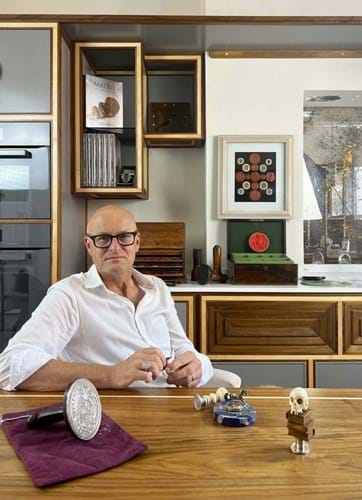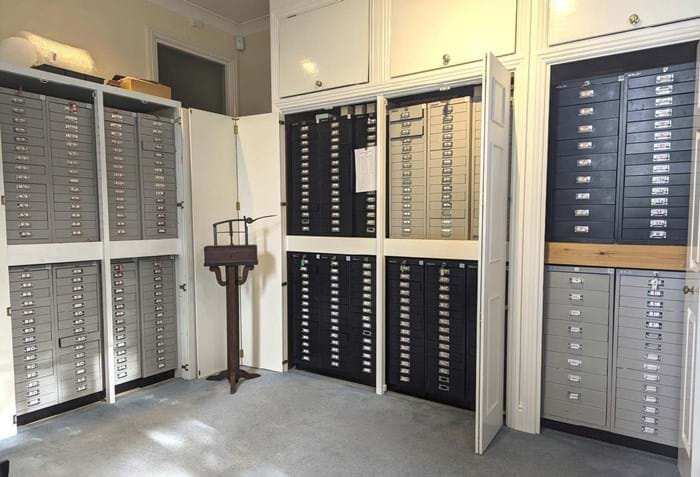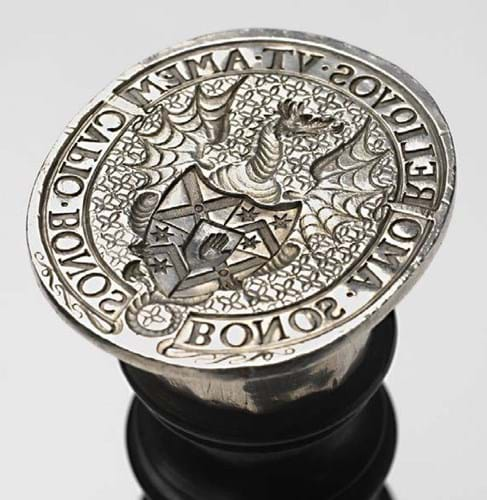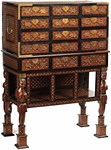David amassed a number of collections including Scottish provincial silver, which he later sold, and focused on hand and desk seals.
He published his book Matrix: A Collection of British Seals in 2012.
Since David’s death in 2021 Andrew has been developing the seals collection in his own right.
What is the Matrix Collection?
Andrew Morris: It is a privately owned collection of hand and desk seals focusing on Great Britain, mainly the domestic history and the country’s influence on the rest of the world, such as the colonies in France and further afield. The collection aims to show key moments in history, whether this be highlighting the important individuals who used the seals to correspond and officiate key moments, or the foundation of key organisations. The seals go far beyond their function, they offer an insight into the political and social context of their day as well as reflecting the fashions of the owner.
The collection is not limited to just hand and desk seals but also a fascinating collection of seal engraver’s boxes, wax stamps and large library of antique seal books.
How were you introduced to the world of collecting?
From a very early age, I was introduced or had a sense of what collecting was about from my late father, who was a collector of many things, but my first recollection is what seemed like a huge collection of wine and classical music. My father obviously felt that it was an important part of my education to appreciate his hobbies as he frequently tested my knowledge, which used to put the fear of God into me! His collecting developed into the ownership and directorship of several antiques shops and it was silver in particular he had a life-long passion for; in fact, he amassed a significant collection of Scottish provincial silver which he sold outright in 1984 at Christie’s Scotland.
I genuinely believe that he felt he had collected pretty much everything of value and decided to move on. This barrier was one reason for him turning to collecting seals which offered somewhat greater scope and one which he was unlikely to reach an end. Plus, he could still collect his beloved silver.
Being brought up in such an environment of collecting, whether it be Scottish silver, huge library of books, live model steam engines etc, made it almost inevitable that I would catch the bug and I vividly remember my first silver spoon aged nine which I made a £3 profit on.

A 19th century aquamarine and gold princely seal - showing the coat of arms of the Prince of Wales, later George IV, between 1801-20.
How did your collecting progress?
Although my 20s and 30s involved being separated from my father’s hobbies, I reconnected again with his passion for seals and wax stamps when I was in my early 40s when I moved back to Hampshire and closer to him. At that point, the collection stood at some 1500 seals and together we formulated a plan to catalogue them before we lost control. This involved me photographing and cataloguing each one, which was the time when I fell in love with the subject rather than having a mere appreciation of it.
The joy of sourcing, identifying and buying a seal was possibly one of our greatest and closest moments a father and son can share and since losing my dad in early 2021, I miss this probably the most.
Managing the collection has now passed over to me and we have ambitions for the future, some of which would amuse my father, others would horrify him (social media in particular!).
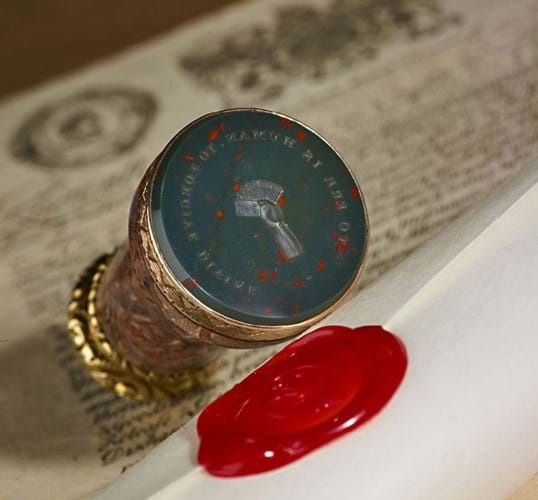
A late 19th century agate, bloodstone and gold mounted desk seal from HRH Albert Edward, Prince of Wales (1841-1910), later Edward VII. It will be offered at Lyon & Turnbull on October 17 with an estimate of £6000-8000. It is known as the ‘Royal Baccarat Scandal’ desk seal (a gambling scandal involving Edward).
Image: Alex Robson.
How do you store or display the collection?
The issue of cataloguing and storage was fortunately addressed at a relatively early stage partly due the safety of the seals and the security, but also to make sure that we could access information and find any seal as easily as possible. In essence, each seal is given a sequential number, the number is fixed to the seal and a plastic sleeve with the same number stores images and reference material is subsequently filed in large foolscap folders. The information is also stored on an electronic database - at the beginning it was on Excel but we have now upgraded it onto customised software. Seals are grouped into categories within foam lined drawers which protect the seal individually and the drawers are also letter coded eg. A - medieval, C - Royal, D - multi-matrices etc.
Naturally, security is taken particularly seriously, and a lot of effort has been spent on insuring their safety from fire and theft. Sadly, for these reasons, it is not possible to display as many as I would choose to have and in some ways a hidden collection is one of my least favourite aspects of collecting, but that is a fact of life. On the other hand, I take great pleasure wearing a sliver medieval seal which although may sound a tad silly is my continual connection to the rest of the collection and my father. My other habit is to always have a few seals within arm’s length, as would befit any passionate collector!
How do you manage the collection?
The question of how best to do this is a constant issue but I have a strong conviction that overgrowing the Matrix Collection has inevitably led to many seals being unknown to me - sometimes I can swear I have never seen that seal before. To me this is clearly a sign that the collection is too big. In order to reduce it to a size which I personally felt it should have always been - somewhere in the 1000-1500 range - involves a lot of objective thinking and selection. This means that all categories have to be thinned out and to be honest it hurts to see some of them go but I know it makes sense and my eyes are very firmly fixed on a collection that I know personally.
It would be easy for me to say that I am simply reducing the collection and that was it. The reality is that I am a born collector, and after 20 years as a buyer it is part of who I am and not easily extinguished as my wife will readily confirm. No, the fact is that I can continue to buy with a strict rule of ‘1 in 2 out’, with an emphasis to always improve; never merely accumulate.
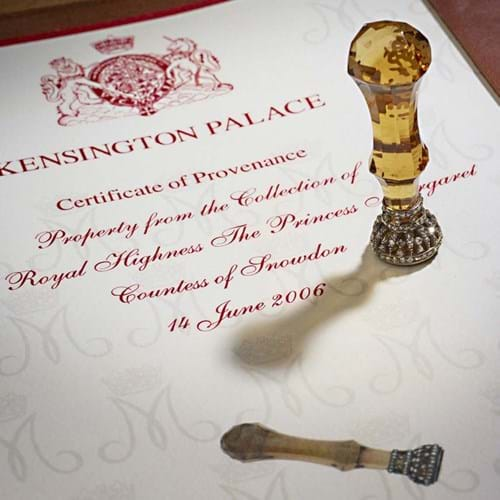
A fine 19th century smoky quartz and diamond-set desk seal, the personal desk seal of HRH Princess Margaret, Countess of Snowdon (1930-2002). It will be offered at L&T on October 17 with an estimate of £6000-8000.
Image: Alex Robson.
How do you choose what to sell?
Once the decision has been made to reduce the collection, the ‘how’ is based on a strategy of doing the best for each seal and the best way of reaching other collectors while being sensitive to the niche-sized market. I think I have spent more time on how best to do this than any other aspect. Fortunately, the collection spans all types, ages, price points so we are fortunate to be able to offer something for nearly every collector. What seems to work well is a combination of quality auction houses, in the UK, Germany and France, plus our own website coupled with a lot of effort by the team in developing Instagram awareness. I have always felt that embarking on this process would be one that I wanted to enjoy as it is an important part of my life and relationships are key to this, I have found.
No more true than with the longstanding relationship with Lyon & Turnbull, a firm my father has worked with for many decades and I am enjoying working with enormously. After an exciting sale of Scottish seals earlier in March this year [as reported in ATG No 2596] we are looking forward to another bumper sale at L&T on October 17, this time on view in the London showroom and featuring some of our very best British seals. In tandem with this, my team has been working hard on developing our own online auctions which we plan to launch this November, giving all seal collectors a go-to place for their hobby.
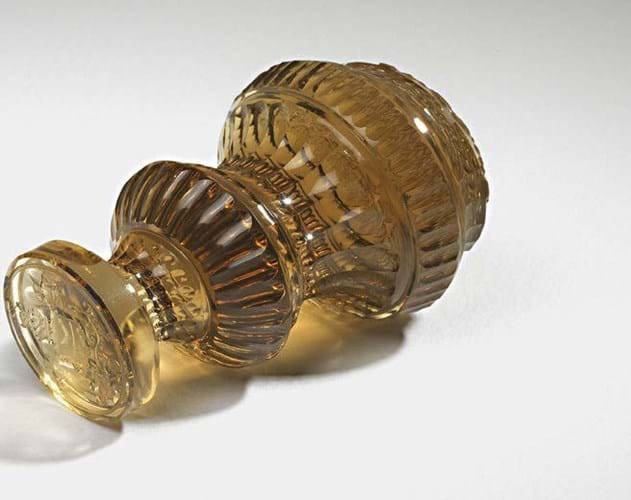
A smoky quartz seal 1887-1900. The motto reads FORTIS IN ARMIS (Strong in Arms) and the arms are those of the Armstrong family of Bamburgh Castle and Cragside, Northumberland.
Where do you find pieces to buy?
The collector in me still enjoys the hunt for new seals to the collection and I can get the same thrill after all these years. Nowadays, I find it harder to find bargains as I am sure most collectors would agree, with internet searches and alerts making it harder still, but that makes the chase even more attractive. The collector in me struggles to hold back against the accumulation temptation and I somewhat reluctantly admit I simply cannot resist a deal when I see it - still, ‘1 in 2 out’!
What’s the most you have spent?
I am often asked what is the most valuable, the most expensive seal in the collection, and I momentarily cringe at the question - not because money can be vulgar but because I react defensively and find the question somehow offends many of the seals that some would not value highly. This is especially true with seals of social and historic value which I personally value higher than the materials perhaps used in their manufacture. So, I would prefer to answer the question that, yes, £10,000s have been spent on some seals with precious metals and gems - and I greatly appreciate the workmanship and skill - but they don’t necessarily speak to me as does a humble pebble cut and polished from a Scottish beach for a laird.
What advice would you give a young collector?
Our website (sigillumseals.co.uk) has been truly wonderful for us in bringing other seal collectors together and I am often asked by enthusiastic seal newbies how to go about this wonderful hobby. As much as I would like to offer some new, deep philosophical suggestions, I have to say that the old adage of ‘collect what you like’ very much still holds water. If I were starting out again, I would concentrate on one very narrow field of seal type and learn everything I could about them and effectively become an expert on that type. I think this brings about many advantages in a subject so wide ranging and the opportunity to be central in a community of other seal collectors.
The other piece of advice I would give is to try and develop an attitude of quality over quantity, never be afraid to ask and finally if you see something you like and your gut agrees, buy it and don’t lose it.


